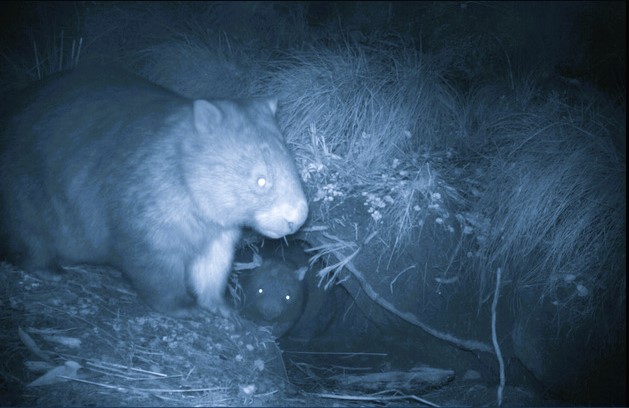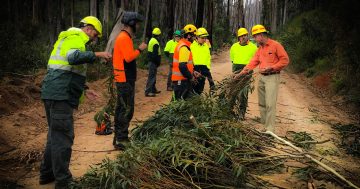
A new study conducted in Woomargama National Park and Woomargama State Forest has highlighted the role wombat burrows play as refuges during and after bushfires. Photos: Grant Linley, Charles Sturt University.
During the Black Summer bushfires of 2019-2020, viral stories emerged on social media of wombats herding native wildlife into their burrows to protect them from fire.
While the scientific community largely dismissed these stories at the time, a new study conducted in forests southeast of Holbrook suggests that an element of truth may still be gleaned from them.
Researchers at Charles Sturt University’s Gulbali Institute have surmised that even if the wombats don’t actually herd wildlife into their homes, their burrows might act as fire refuges – providing vital shelter, food and even drinking water – during and after a bushfire.
The research focused on the burrows of common wombats (Vombatus ursinus) – a complex underground tunnelling system that can be more than 15 metres long with multiple entrances and chambers – in Woomargama National Park and Woomargama State Forest.
It was here that more than 18,000 hectares of bushland was razed by fire, ignited by a lightning strike on 29 December, 2019, and finally extinguished on 18 February, 2020.
Sixteen months after the fires, scientists set up sensor cameras in front of 28 wombat burrows situated amid varying degrees of fire severity and at 28 control locations nearby with the same fire severity but without burrows.
Between June 2021 and April 2022, the cameras recorded more than 746,670 images containing 370,845 wildlife images, which, when compressed, identified 56 species: 47 of them native and nine introduced.
The cameras recorded 30 species inspecting a burrow, 11 foraging at a burrow, 10 entering or leaving a burrow, four drinking from a flooded burrow, and one bathing in a flooded one.
Native species such as bush rats, agile antechinus, lace monitors, painted button-quails, and grey shrike-thrush were more prevalent around burrows compared with similar sites without burrows.
Lead author Grant Linley, an ecologist and PhD candidate with the Gulbali Institute, said the burrow sites demonstrated higher native “mammal species richness”.
In short, the study found that wombats, by turning over tonnes of soil while constructing a burrow and leaving nitrogen-rich droppings, altered the soil, topography, and vegetation around their burrows.
“We think these changes increase the foraging opportunities for small insectivores and omnivores, such as bush rats, agile antechinus, grey shrike-thrush and painted button-quails and that’s why we see more activity by these species around burrows,” Mr Linley said.
He said small vertebrates hanging around wombat burrows could then be drawing in larger native predators, such as lace monitors.
“So, the impact of burrows may be cascading through the system,” Mr Linley explained.

Scientists set up sensor cameras, in Woomargama National Park and Woomargama State Forest, in front of 28 wombat burrows situated amid varying degrees of fire severity and at 28 control locations nearby with the same fire severity but without burrows.
The study found smaller species were more active around burrows and larger species less active, with larger animals excluded from utilising the available shelter and foraging potential due to the size of the burrow openings.
Several instances of common wombat burrows filling with water, including during summer, signalled that water provision may be another ecological role that they provide.
Macropods including the eastern grey kangaroo, red-necked wallaby and swamp wallaby were all captured drinking from burrows, and pied currawongs were observed bathing.
Study co-author, Professor Dale Nimmo from Charles Sturt University’s Gulbali Institute, said aside from better foraging opportunities, the use of burrows as a refuge from predators may also be attracting small animals.
“Many resources critical for species survival, such as logs, were destroyed by severe fires,” he said. “We found associations between species and burrows were often strengthened in fire-impacted habitat.”
For example, agile antechinus, bush rats and painted button-quails – all smaller-sized animals – were most active at burrows subject to high-severity fire, Professor Nimmo said.
He said wombat burrows, which survive fire and can persist for decades, were potentially aiding in the survival, persistence and recovery of animal populations following severe wildfire events.
Co-author Dr Kita Ashman, a conservation scientist with World Wildlife Fund (WWF)-Australia, said wombat burrows could help some species deal with the challenges of climate change.
“Wombats’ extensive burrow systems can create microhabitats that enhance water retention, assist in nutrient cycling and contribute to overall ecosystem resilience,” Dr Ashman said.
”In an increasingly unstable climate, wombats can be valuable agents in adapting to and mitigating some of the impacts of climate change.”
However, the study comes with a warning.
“Common wombats are in decline, their range is contracting, and we need to turn that around,” Mr Linley said.
”They’re the only surviving native species capable of digging deep, wide burrows. Their value as providers of shelter and a refuge for numerous species is only going to increase as fires become more intense in the future.”
Original Article published by Edwina Mason on About Regional.








